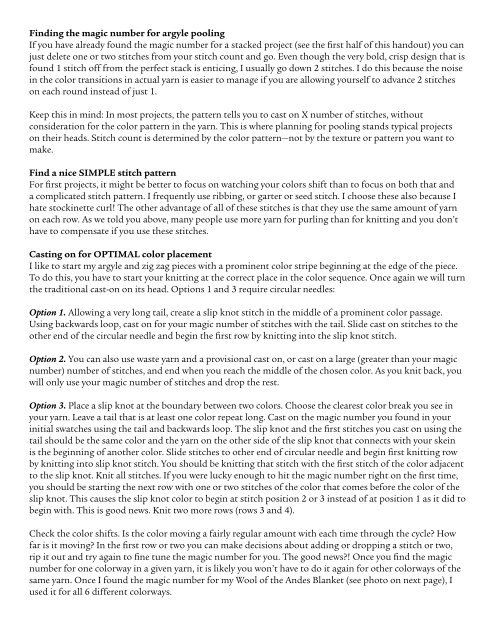Introduction to Planned Pooling - Sock Summit 2011
Introduction to Planned Pooling - Sock Summit 2011
Introduction to Planned Pooling - Sock Summit 2011
You also want an ePaper? Increase the reach of your titles
YUMPU automatically turns print PDFs into web optimized ePapers that Google loves.
Finding the magic number for argyle pooling<br />
If you have already found the magic number for a stacked project (see the first half of this handout) you can<br />
just delete one or two stitches from your stitch count and go. Even though the very bold, crisp design that is<br />
found 1 stitch off from the perfect stack is enticing, I usually go down 2 stitches. I do this because the noise<br />
in the color transitions in actual yarn is easier <strong>to</strong> manage if you are allowing yourself <strong>to</strong> advance 2 stitches<br />
on each round instead of just 1.<br />
Keep this in mind: In most projects, the pattern tells you <strong>to</strong> cast on X number of stitches, without<br />
consideration for the color pattern in the yarn. This is where planning for pooling stands typical projects<br />
on their heads. Stitch count is determined by the color pattern—not by the texture or pattern you want <strong>to</strong><br />
make.<br />
Find a nice SIMPLe stitch pattern<br />
For first projects, it might be better <strong>to</strong> focus on watching your colors shift than <strong>to</strong> focus on both that and<br />
a complicated stitch pattern. I frequently use ribbing, or garter or seed stitch. I choose these also because I<br />
hate s<strong>to</strong>ckinette curl! The other advantage of all of these stitches is that they use the same amount of yarn<br />
on each row. As we <strong>to</strong>ld you above, many people use more yarn for purling than for knitting and you don’t<br />
have <strong>to</strong> compensate if you use these stitches.<br />
Casting on for oPTIMAL color placement<br />
I like <strong>to</strong> start my argyle and zig zag pieces with a prominent color stripe beginning at the edge of the piece.<br />
To do this, you have <strong>to</strong> start your knitting at the correct place in the color sequence. Once again we will turn<br />
the traditional cast-on on its head. Options 1 and 3 require circular needles:<br />
Option 1. Allowing a very long tail, create a slip knot stitch in the middle of a prominent color passage.<br />
Using backwards loop, cast on for your magic number of stitches with the tail. Slide cast on stitches <strong>to</strong> the<br />
other end of the circular needle and begin the first row by knitting in<strong>to</strong> the slip knot stitch.<br />
Option 2. You can also use waste yarn and a provisional cast on, or cast on a large (greater than your magic<br />
number) number of stitches, and end when you reach the middle of the chosen color. As you knit back, you<br />
will only use your magic number of stitches and drop the rest.<br />
Option 3. Place a slip knot at the boundary between two colors. Choose the clearest color break you see in<br />
your yarn. Leave a tail that is at least one color repeat long. Cast on the magic number you found in your<br />
initial swatches using the tail and backwards loop. The slip knot and the first stitches you cast on using the<br />
tail should be the same color and the yarn on the other side of the slip knot that connects with your skein<br />
is the beginning of another color. Slide stitches <strong>to</strong> other end of circular needle and begin first knitting row<br />
by knitting in<strong>to</strong> slip knot stitch. You should be knitting that stitch with the first stitch of the color adjacent<br />
<strong>to</strong> the slip knot. Knit all stitches. If you were lucky enough <strong>to</strong> hit the magic number right on the first time,<br />
you should be starting the next row with one or two stitches of the color that comes before the color of the<br />
slip knot. This causes the slip knot color <strong>to</strong> begin at stitch position 2 or 3 instead of at position 1 as it did <strong>to</strong><br />
begin with. This is good news. Knit two more rows (rows 3 and 4).<br />
Check the color shifts. Is the color moving a fairly regular amount with each time through the cycle? How<br />
far is it moving? In the first row or two you can make decisions about adding or dropping a stitch or two,<br />
rip it out and try again <strong>to</strong> fine tune the magic number for you. The good news?! Once you find the magic<br />
number for one colorway in a given yarn, it is likely you won’t have <strong>to</strong> do it again for other colorways of the<br />
same yarn. Once I found the magic number for my Wool of the Andes Blanket (see pho<strong>to</strong> on next page), I<br />
used it for all 6 different colorways.


